Are Rainfall and Temperature Really Changing? Farmer’s Perceptions, Meteorological Data, and Policy Implications in the Tanzanian Semi-Arid Zone
Abstract
:1. Introduction
2. Materials and Methods
2.1. Profile of the Study Site
2.2. Biophysical Characteristics of the Study Area
2.3. Data Collection
2.4. Data Analyses
3. Results
3.1. Characteristics of the Respondents
3.2. Farmers’ Perceptions on Temperature and Rainfall
3.2.1. Overall Perception
3.2.2. Specific Perceptions during the Growing Season
3.3. Results from Meteorological Data Analyses
3.3.1. Rainfall
3.3.2. Temperature
3.4. Community-Based Adaptation Measures to Climate Change Impacts
4. Discussion
5. Conclusions
Acknowledgments
Author Contributions
Conflicts of Interest
References
- Challinor, A.J.; Wheeler, T.R.; Garforth, C.; Craufurd, P.; Kassam, A. Assessing the vulnerability of food crop systems in Africa to climate change. Clim. Chang. 2007, 83, 381–399. [Google Scholar] [CrossRef]
- Challinor, A.J.; Watson, J.; Lobell, D.B.; Howden, S.M.; Smith, D.R.; Chhetri, N. A meta-analysis of crop yield under climate change and adaptation. Nat. Clim. Chang. 2014, 4, 287–291. [Google Scholar] [CrossRef]
- Adger, N. Vulnerability. Glob. Environ. Chang. 2006, 268–281. [Google Scholar] [CrossRef]
- Ahmed, S.; Deffenbaugh, N.; Hertel, T.; Lobell, D.; Ramankutty, N.; Rios, A.; Rowhani, P. Climate volatility and poverty vulnerability in Tanzania. Glob. Environ. Chang. 2011, 21, 46–55. [Google Scholar] [CrossRef]
- Paavola, J. Livelihoods, vulnerability and adaptation to climate change in Morogoro, Tanzania. Environ. Sci. Policy 2008, 11, 642–654. [Google Scholar] [CrossRef]
- Intergovernmental Panel on Climate Change (2014a) Climate Change Impacts. Adaptation, and Vulnerability. Part A: Global and Sectoral Aspects. Contribution of Working Group II to the Fifth Assessment Report of the Intergovernmental Panel on Climate Change; Field, C.B., Barros, V.R., Estrada, R.C., Genova, B., Girma, E.S., Kissel, A.N., Levy, S., MacCracken, P.R., Mastrandrea, L.L., Eds.; Cambridge University Press: Cambridge, UK; New York, NY, USA, 2014. [Google Scholar]
- Below, T.; Schmid, J.; Sieber, S. Farmers’ knowledge and perception of climatic risks and options for climate change adaptation: A case study from two Tanzanian villages. Reg. Environ. Chang. 2015, 15, 1169–1180. [Google Scholar] [CrossRef]
- Rowhani, P.; Lobell, D.B.; Linderman, M.; Ramankutty, N. Climate variability and crop production in Tanzania. Agric. For. Meteorol. 2011, 15, 449–460. [Google Scholar] [CrossRef]
- Dessai, S.; Adger, W.N.; Hulme, M.; Turnpenny, J.; Kohler, J.; Warren, R. Defining and experiencing dangerous climate change. Clim. Chang. 2004, 64, 11–25. [Google Scholar] [CrossRef]
- Mongi, H.; Majule, A.E.; Lyimo, J.G. Vulnerability Assessment of Rain-fed Agriculture to Climate Change and Variability in Semi-arid areas of Tanzania. Afr. J. Environ. Sci. Technol. 2010, 4, 370–383. [Google Scholar]
- Sovacool, B.; Linnér, B.; Klein, R. Climate change adaptation and the Least Developed Countries Fund (LDCF): Qualitative insights from policy implementation in the Asia-Pacific. Clim. Chang. 2017, 140, 209–226. [Google Scholar] [CrossRef]
- IPCC. Managing the risks of extreme events and disasters to advance climate change adaptation. In A Special Report of Working Groups I and II of the Intergovernmental Panel on Climate Change; Field, C.B., Barros, V., Stocker, T.F., Qin, D., Dokken, D.J., Ebi, K.L., Mastrandrea, M.D., Mach, K.J., Plattner, G.-K., Allen, S.K., et al., Eds.; Cambridge University Press: Cambridge, UK, 2012. [Google Scholar]
- Sieber, S.; Tscherning, K.; Graef, F.; Sergio, U.; Paloma, G. Food security in the context of climate change and bioenergy production in Tanzania: Methods, tools and applications. Reg. Environ. Chang. 2015, 15, 1163–1168. [Google Scholar] [CrossRef]
- Kilembe, C.; Thomas, T.S.; Waithaka, M.; Kyotalimye, M.; Tumbo, S. East African Agriculture and Climate Change: A Comprehensive Analysis—Tanzania; IFPRI: Washington, DC, USA, 2012. [Google Scholar]
- Lobell, D.B.; Burke, M.B. On the use of statistical models to predict crop yield responses to climate change. Agric. For. Meteorol. 2010, 150, 1443–1452. [Google Scholar] [CrossRef]
- Lobell, D.B.; Burke, M.B.; Tebaldi, C.; Mastrandrea, M.D.; Falcon, W.P.; Naylor, R.L. Prioritizing climate change adaptation needs for food security in 2030. Science 2008, 319, 607–610. [Google Scholar] [CrossRef] [PubMed]
- Msongaleli, B.; Rwehumbiza, F.; Tumbo, S.; Kihupi, N. Impacts of Climate Variability and Change on Rainfed Sorghum and Maize: Implications for Food Security Policy in Tanzania. J. Agric. Sci. Can. Cent. Sci. Educ. 2015, 7, 124–142. [Google Scholar] [CrossRef]
- Mkonda, M.Y. Rainfall variability and its association to the trends of crop production in Mvomero District, Tanzania. Eur. Sci. J. 2014, 10, 263–273. [Google Scholar]
- FAO. Declaration of the world summit on food security. In World Summit on Food Security; FAO: Rome, Italy, 2009; pp. 16–18. [Google Scholar]
- Kangalawe, R. Climate change impacts on water resource management and community livelihoods in the southern highlands of Tanzania. Clim. Dev. 2016. [Google Scholar] [CrossRef]
- Kangalawe, R.; Lyimo, G. Climate Change, Adaptive Strategies and Rural Livelihoods in Semiarid Tanzania. Nat. Resour. 2013, 4, 266–278. [Google Scholar] [CrossRef]
- Cooper, S.J.; Wheeler, T. Rural household vulnerability to climate risk in Uganda. Reg. Environ. Chang. 2017, 17, 649–663. [Google Scholar] [CrossRef]
- URT. National Agriculture Policy; Government Publishing Press: Dar es Salaam, Tanzania, 2013.
- URT. Poverty and Human Development Report; Research and Analysis working Group: Dar es Salaam, Tanzania, 2009. [Google Scholar]
- URT. United Republic of Tanzania, National Adaptation Programme of Action (NAPA); Division of Environment, Vice President’s Office: Dar es Salaam, Tanzania, 2007. [Google Scholar]
- URT. The Agricultural Sector Development Programme; The Agricultural Sector Lead Ministries: Dar es Salaam, Tanzania, 2002. [Google Scholar]
- URT. National Environmental Policy; Government Publishing Press: Dar es Salaam, Tanzania, 1997.
- Yanda, P. Climate Change Implications for Management and Use of Agricultural Biodiversity Resources in Africa. Environ. Ecol. Res. 2015, 3, 35–43. [Google Scholar] [CrossRef]
- Birkmann, J.; Cutter, S.L.; Rothman, D.S.; Welle, T.; Garschagen, M.; van Ruijven, B.; O’Neill, B.; Preston, B.L.; Kienberger, S.; Cardona, O.D.; et al. Scenarios for vulnerability: Opportunities and constraints in the context of climate change and disaster risk. Clim. Chang. 2013. [Google Scholar] [CrossRef]
- Meehl, G.A.; Goddard, L.; Murphy, J.; Stouffer, R.J.; Boer, G.; Danabasoglu, G.; Dixon, K.; Giorgetta, M.A.; Greene, A.M.; Hawkins, E.; et al. Decadal prediction. Bull. Am. Meteorol. Soc. 2009, 459, 1467–1485. [Google Scholar] [CrossRef]
- Kimaro, A.; Mpanda, M.; Rioux, J.; Aynekulu, E.; Shaba, S.; Thiong’o, M.; Mutuo, P.; Abwanda, S. Is conservation agriculture ‘climate-smart’ for maize farmers in the highlands of Tanzania? Nutr. Cycl. Agroecosyst. 2015, 3, 217–228. [Google Scholar] [CrossRef]
- Speranza, I.; Kiteme, B.; Ambenje, P.; Wiesmann, U.; Makali, S. Indigenous knowledge related to climate variability and change: Insights from droughts in semi-arid areas of former Makueni District, Kenya. Clim. Chang. 2009, 100, 295–315. [Google Scholar] [CrossRef]
- Nyong, A.; Francis, A.; Osman-Elasha, B. The value of indigenous knowledge in climate change mitigation and adaptation strategies in the African Sahel. Mitig. Adapt. Strat. Glob. Chang. 2007, 12, 787–797. [Google Scholar] [CrossRef]
- Rao, K.; Ndegwa, W.; Kizito, K.; Oyoo, A. Climate Variability and Change: Farmer Perceptions and Understanding of Intra-Seasonal Variability in Rainfall and Associated Risk in Semi-Arid Kenya. Exp. Agric. 2011, 47, 267–291. [Google Scholar] [CrossRef]
- Salick, J. Traditional peoples and climate change. Glob. Environ. Chang. 2009, 19, 137–139. [Google Scholar] [CrossRef]
- Grothmann, T.; Petzold, M.; Ndaki, P.; Kakembo, V.; Siebenhüner, B.; Kleyer, M.; Yanda, P.; Ndou, N. Vulnerability Assessment in African Villages under Conditions of Land Use and Climate Change: Case Studies from Mkomazi and Keiskamma. Sustainability 2017, 9, 976. [Google Scholar] [CrossRef]
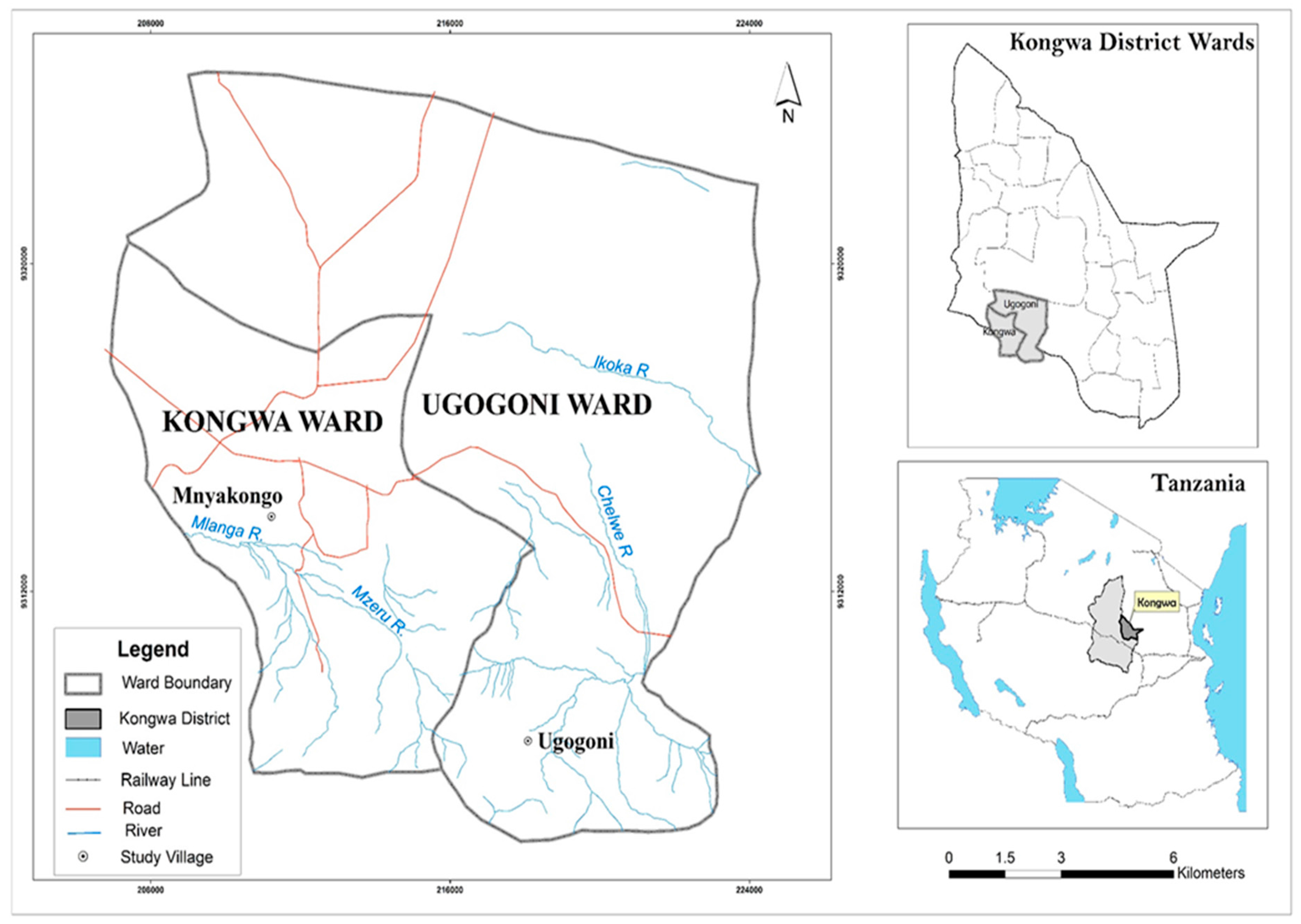
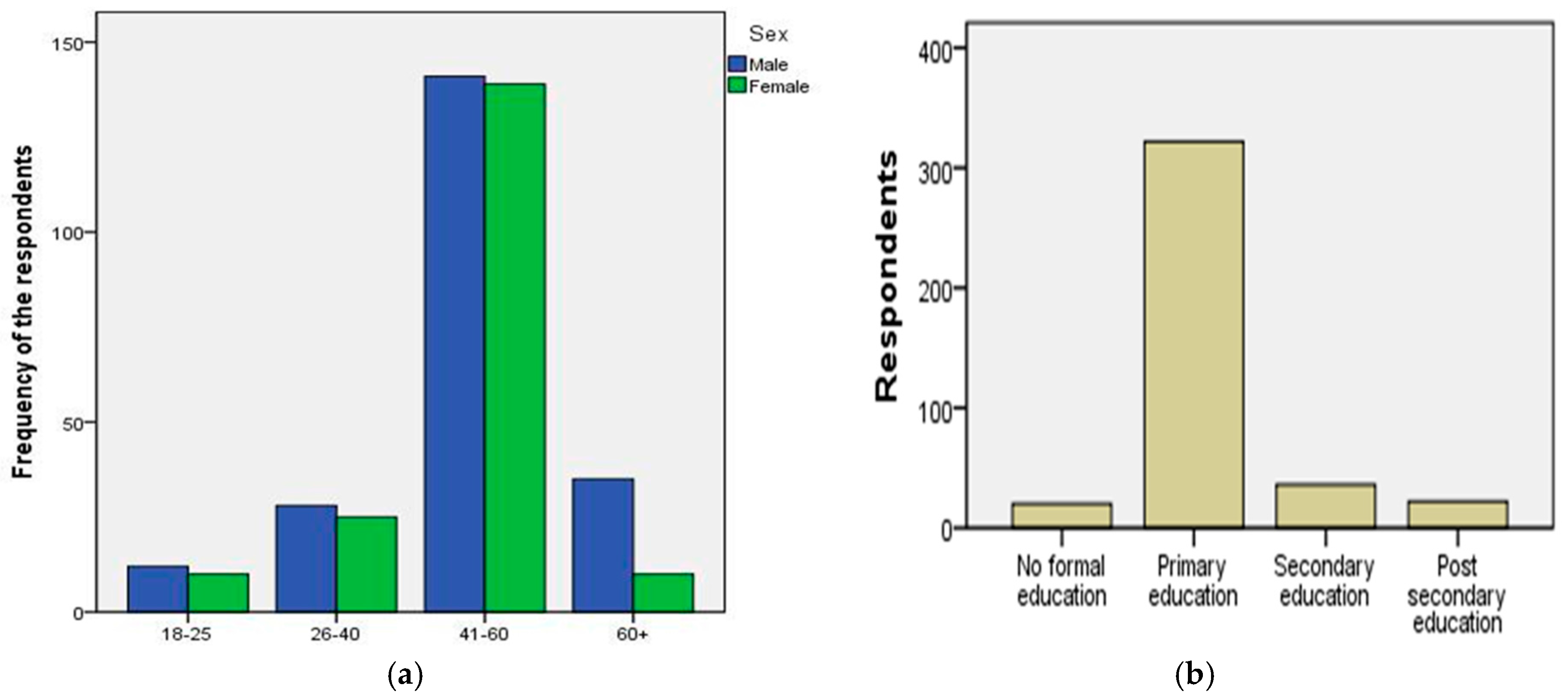
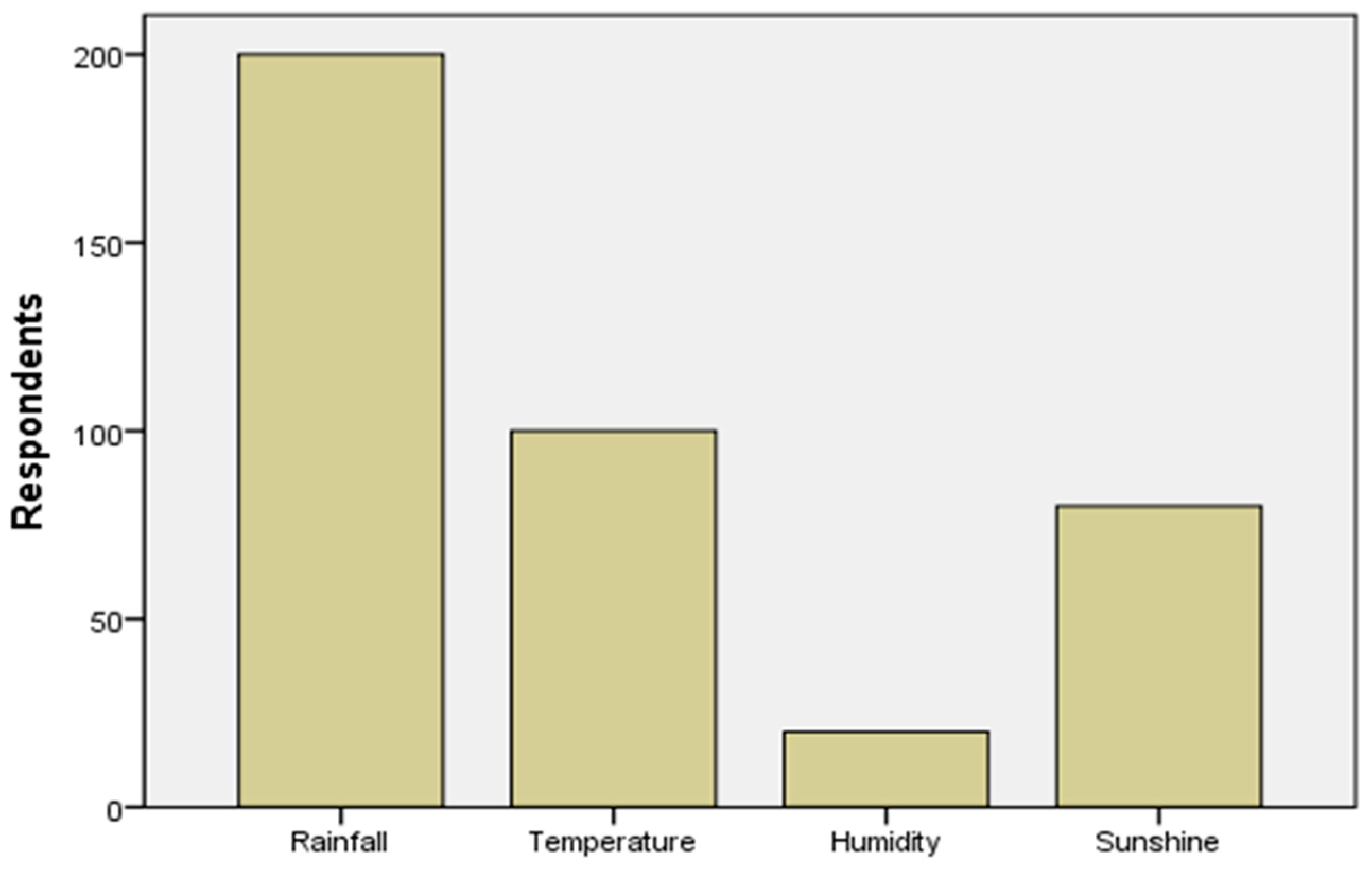
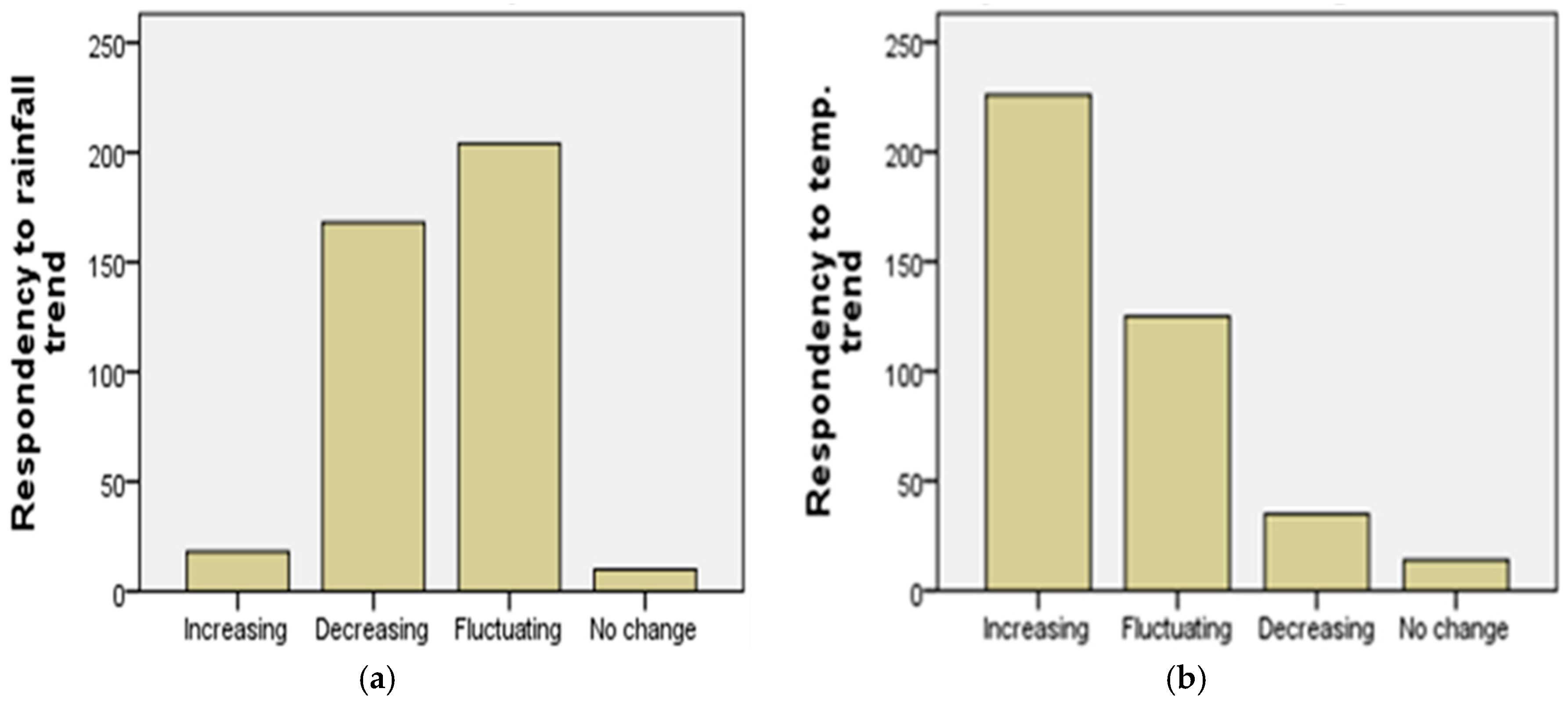
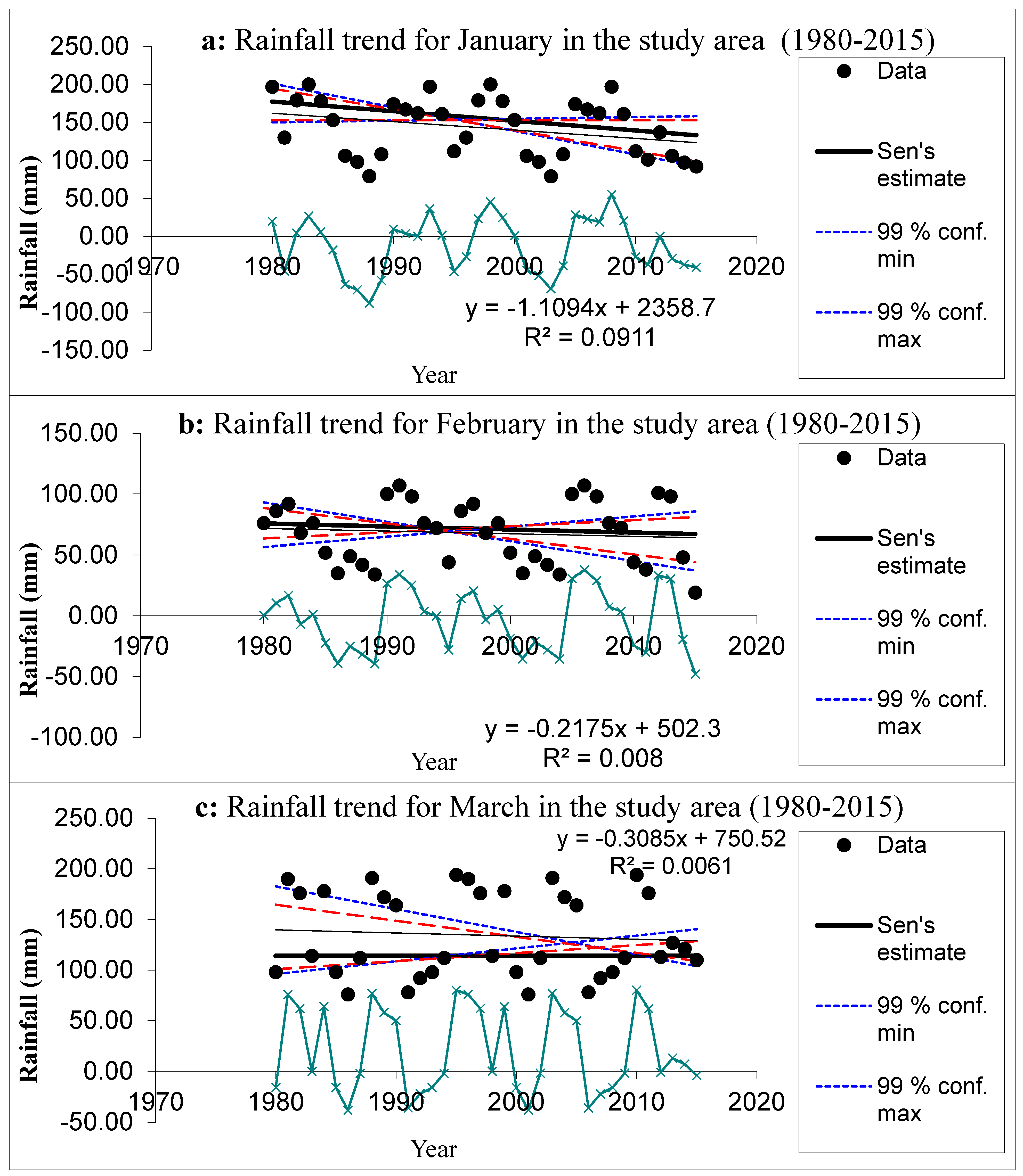
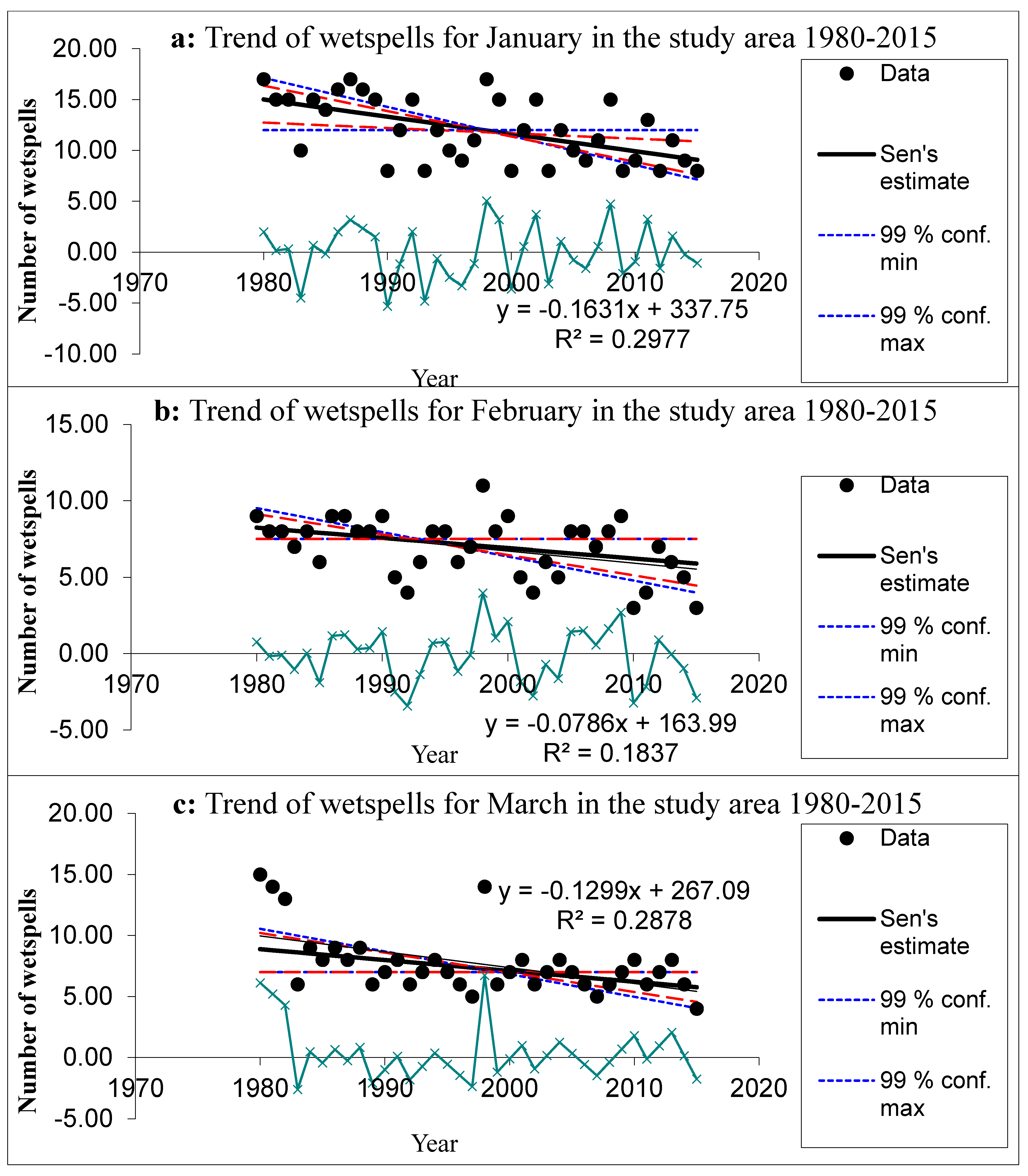
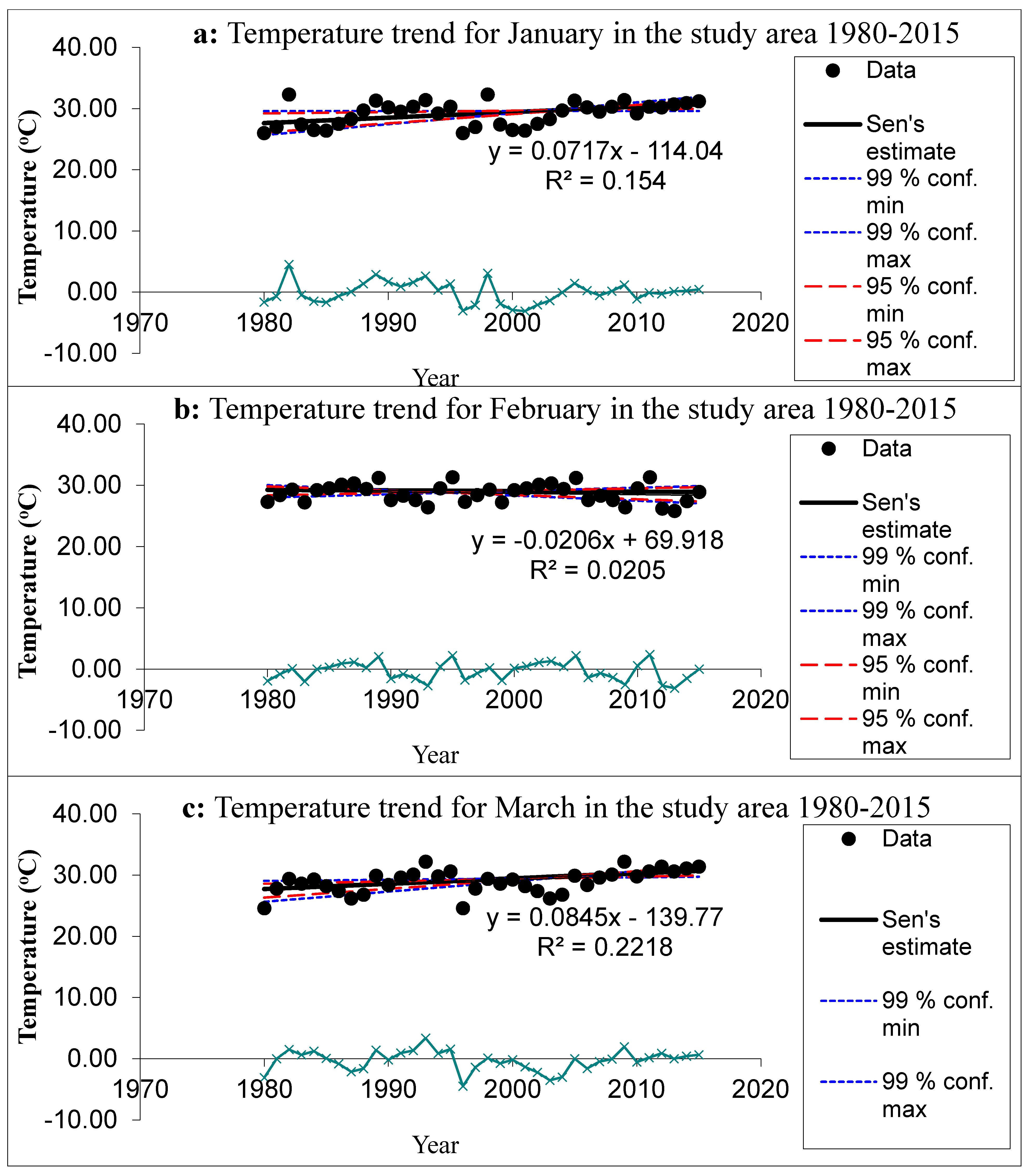
| Region | District | Village | Total Households | Respondents |
|---|---|---|---|---|
| Dodoma | Kongwa | Mnyakongo | 2050 | 200 |
| Ugogoni | 2080 | 200 |
| Variable | Percent of Respondents |
|---|---|
| (a) Temperature | |
| Temperature increased | 80 |
| Temperature decreased | 8 |
| Temperature stayed the same | 12 |
| (b) Rainfall | |
| Rainfall increased | 15 |
| Rainfall decreased | 60 |
| Rainfall stayed the same | 25 |
| Number of respondents | 400 |
| Adaptation Activities | Mnyakongo (N = 200) | Ugogoni (N = 200) | Total (N = 400) |
|---|---|---|---|
| Timing of farm operations e.g., planting | 70 | 51 | 60.5 |
| Planting early maturing varieties | 52 | 37 | 44.5 |
| Little tillage | 47 | 35 | 41.0 |
| Mulching | 35 | 43 | 39.0 |
| Agroforestry | 23 | 25 | 24.0 |
| Plating high yielding varieties | 17 | 14 | 15.5 |
| Practicing crop rotation | 10 | 6 | 8.0 |
| Small-scale irrigation | 9 | 4 | 6.5 |
| Adaptation Activities | Mnyakongo (N = 200) | Ugogoni (N = 200) | Total (N = 400) |
|---|---|---|---|
| Great supply of drought resistant crops and cultivars | 60 | 51 | 55.5 |
| Heavy investment in irrigation technologies | 72 | 77 | 74.5 |
| Strengthening Rain Water Harvest technology | 70 | 65 | 70 |
| Emphasis on organic fertilization | 80 | 70 | 75 |
| To maximize crop production during good years | 72 | 74 | 73 |
| Emphasis on transformative climate adaptation | 60 | 54 | 57 |
| Agricultural Policy should address the current challenge | 57 | 63 | 60 |
| The government should put a direct hand in agriculture | 60 | 55 | 57.5 |
| Increased government’s willingness to address climate impacts | 77 | 83 | 80 |
© 2017 by the authors. Licensee MDPI, Basel, Switzerland. This article is an open access article distributed under the terms and conditions of the Creative Commons Attribution (CC BY) license (http://creativecommons.org/licenses/by/4.0/).
Share and Cite
Mkonda, M.Y.; He, X. Are Rainfall and Temperature Really Changing? Farmer’s Perceptions, Meteorological Data, and Policy Implications in the Tanzanian Semi-Arid Zone. Sustainability 2017, 9, 1412. https://doi.org/10.3390/su9081412
Mkonda MY, He X. Are Rainfall and Temperature Really Changing? Farmer’s Perceptions, Meteorological Data, and Policy Implications in the Tanzanian Semi-Arid Zone. Sustainability. 2017; 9(8):1412. https://doi.org/10.3390/su9081412
Chicago/Turabian StyleMkonda, Msafiri Y., and Xinhua He. 2017. "Are Rainfall and Temperature Really Changing? Farmer’s Perceptions, Meteorological Data, and Policy Implications in the Tanzanian Semi-Arid Zone" Sustainability 9, no. 8: 1412. https://doi.org/10.3390/su9081412
APA StyleMkonda, M. Y., & He, X. (2017). Are Rainfall and Temperature Really Changing? Farmer’s Perceptions, Meteorological Data, and Policy Implications in the Tanzanian Semi-Arid Zone. Sustainability, 9(8), 1412. https://doi.org/10.3390/su9081412






